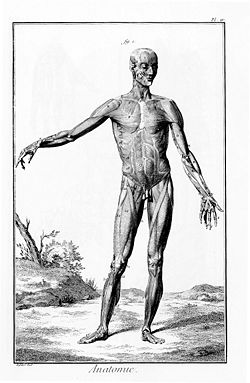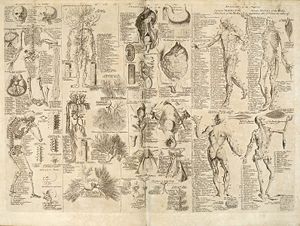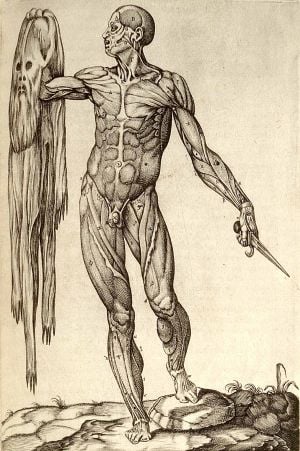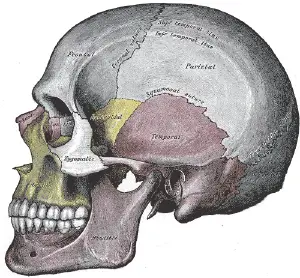Difference between revisions of "Anatomy" - New World Encyclopedia
Rick Swarts (talk | contribs) |
Glenn Strait (talk | contribs) |
||
| Line 1: | Line 1: | ||
| − | {{Paid}}{{Approved}}{{Images OK}}{{Submitted}}{{Contracted}}{{copyedited}} | + | {{Edboard}}{{Paid}}{{Approved}}{{Images OK}}{{Submitted}}{{Contracted}}{{copyedited}} |
[[Image:ENC plate 1-143 750px.jpeg|thumb|250px|Anatomical drawing of the human muscles from the ''Encyclopédie''.]] | [[Image:ENC plate 1-143 750px.jpeg|thumb|250px|Anatomical drawing of the human muscles from the ''Encyclopédie''.]] | ||
Revision as of 15:57, 4 January 2008
Anatomy can refer either to the internal structure and organization of an organism or any of its parts, or to the branch of biology that deals with the study of internal structure and organization of living things and their parts. In this sense, it is synonymous with internal morphology (Towle 1989). General morphology, however, also deals with external structure.
Since the function of a part is related to its structure, anatomy naturally is related to physiology, a term that refers to the mechanical, physical, and biochemical functions of living organisms and their parts, or to the study of those functions.
The history of the study of anatomy reflects human creativity, curiosity, heart, and reason. Ideally, those researching human anatomy are motivated by a desire to help others (heart), use reason in their scientific explorations, have a curiosity to understand, and approach the subject creatively. In many ways, the history of anatomy has reflected those attributes. However, sometimes human action has been motivated by reason without heart, or by self-centeredness, and thus the history of anatomy also includes cases like body snatching and even murder in order to secure cadavers for research, as well as suppression of research because of religious fear.
Anatomy can be divided into animal anatomy and plant anatomy (or phytotomy). (Study of external plant structure is known as plant morphology.) Anatomy can also be covered either regionally or systemically; that is, relating to particular bodily regions, such as the head and chest for the former, or specific systems, such as the nervous or respiratory systems for the latter.
Major branches of the science of anatomy include comparative anatomy, cytology, histology, and human anatomy. Comparative anatomy is the study of similarities and differences in the structure and organization of organisms. Cytology is the study of cells, and examines their internal anatomy. Histology is the study of aggregates of cells called tissues. Human anatomy, or anthropotomy, is a special field within anatomy and studies structures and systems of the human body.
The term anatomy comes from the Greek ἀνατομία anatomia, from ἀνατέμνειν anatemnein, meaning to cut up or cut open.
History of (human) anatomy
The history of anatomy as a science extends from the earliest examinations of sacrificial victims to the sophisticated analysis of the body performed by modern scientists. It has been marked, over time, by a continually developing understanding of the functions of organs and structures in the body. Methods have also advanced dramatically, from examination of animals through dissection of cadavers to technologically complex techniques developed in the twentieth century. The following is largely a history centered on the developing science of studying human anatomy.
Ancient anatomy
Egypt
The study of anatomy began at least as early as 1600 B.C.E., the date of the ancient Egyptian Edwin Smith papyrus. This treatise shows that the heart, its vessels, liver, spleen, kidneys, uterus, and bladder were recognized, and that the blood vessels were known to come from the heart. Other vessels are described, some carrying air, some mucus, while two to the right ear are said to carry the "breath of life," and two to the left ear the "breath of death." The Ebers papyrus (c. 1550 B.C.E.) features a treatise on the heart. It notes that the heart is the center of the blood supply, with vessels attached for every member of the body. The Egyptians seem to have known little about the function of the kidneys and made the heart the meeting point of a number of vessels that carried all the fluids of the body—blood, tears, urine, and sperm (Porter 1997).
Greece
The earliest medical scientist of whose works any great part survives today is Hippocrates, an ancient Greek physician active in the late fifth and early fourth centuries B.C.E. (460-377 B.C.E.). His work demonstrates a basic understanding of musculoskeletal structure, and the beginnings of understanding of the function of certain organs, such as the kidneys. Much of his work, however, and much of that of his students and followers later, relies on speculation rather than empirical observation of the body.
In the fourth century B.C.E., Aristotle and several contemporaries produced a more empirically founded system, based on dissection of animals. Works produced around this time are the first to identify the difference between arteries and veins, and the relations between organs are described more accurately than in previous works.
The first use of human cadavers for anatomical research occurred later in the fourth century B.C.E. when Herophilos and Erasistratus performed dissections of cadavers in Alexandria under the auspices of the Ptolemaic dynasty. Herophilos in particular developed a body of anatomical knowledge much more informed by the actual structure of the human body than previous works had been.
Galen
The final major anatomist of ancient times was Galen, active in the second century. He compiled much of the knowledge obtained by previous writers, and furthered the inquiry into the function of organs by performing vivisection on animals. His collection of drawings, based mostly on dog anatomy, became the anatomy textbook for 1500 years. The original text is long gone, and his work was only known to the Renaissance doctors through the careful custody of Arabic medicine, since the Roman Catholic Church destroyed the work as heresy. Hampered by the same religious restrictions as anatomists for centuries after him, Galen assumed that anatomical structures in dogs were the same as for humans.[1]
Medieval to early modern anatomy
Little progress was made in anatomy for some time after the fall of the Roman empire. Although Arab scientists contributed heavily to medieval learning and culture, taboos against handling corpses limited their contributions to anatomical research. The first major development in anatomy after Galen occurred at Bologna in the fourteenth to sixteenth centuries, where a series of authors dissected cadavers and further contributed to the accurate description of organs and the identification of their functions. Prominent among these anatomists were Mondino de Liuzzi and Alessandro Achillini.
The sixteenth century also saw the first challenges to Galen. Thanks to the printing press, all over Europe a collective effort proceeded to distill the original Galen from the various, mostly Arab, added texts. Vesalius was the first to publish a treatise that challenged him "drawing for drawing," traveling all the way from Leuven[2] to Padua for permission to dissect victims from the gallows without fear of persecution. His drawings are triumphant descriptions of the, sometimes major, discrepancies between dogs and humans, showing superb drawing ability. Many later anatomists challenged Galen in their texts, though Galen reigned supreme for another century.
A succession of researchers proceeded to further refine the body of anatomical knowledge, giving their names to a number of anatomical structures along the way. The sixteenth and seventeenth centuries also witnessed significant advances in the understanding of the circulatory system, as the purpose of valves in veins was identified, the left-to-right ventricle flow of blood through the circulatory system was described, and the hepatic veins were identified as a separate portion of the circulatory system. The lymphatic system was also identified as a separate system at this time.
Seventeenth and eighteenth century anatomy
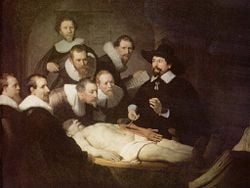
The study of anatomy flourished in the seventeenth and eighteenth centuries. With the aid of the printing press, the exchange of ideas across Europe was easily facilitated. Since the study of anatomy concerned observation and drawings, the popularity of the anatomist was equal to the quality of his drawing talents, and one need not be an expert in Latin to take part. [3] Many famous artists studied anatomy, attended dissections, and published drawings for money, from Michelangelo to Rembrandt. For the first time, prominent universities could teach something about anatomy through drawings, rather than relying on knowledge of Latin.
The only stumbling block was a possible reprimand from the Church, which frightened several anatomists of that time from performing dissections on their own kind. Though a very fruitful period for the sciences, the Renaissance could be dangerous, as is seen in the case of Galileo. Some scientists of the time were scared enough to keep moving from city to city. Descartes is a prime example. Though all physicians agreed that a sound knowledge of anatomy was important to perform medicine, only certified anatomists were allowed to perform dissections, sometimes only yearly. These dissections were sponsored by the city councilors and often charged an admission fee, rather like a circus act for scholars. Many European cities, such as Amsterdam, London, Copenhagen, Padua, and Paris, all had Royal anatomists (or some such office) tied to local government. Indeed, Nicolaes Tulp was Mayor of Amsterdam for three terms. Though it was a risky business to perform dissections, attending dissections was perfectly legal, and many anatomy students traveled around Europe from dissection to dissection during the course of their study.
Many Europeans interested in the study of anatomy traveled to Italy, where the center of anatomy resided. Only in Italy could certain important research methods, such as dissections on women, be used. M. R. Columbus and Gabriele Falloppio were pupils of Vesalius, the sixteenth century anatomist. Columbus, as his immediate successor in Padua, and afterwards professor at Rome, distinguished himself by rectifying and improving the anatomy of the bones; by giving correct accounts of the shape and cavities of the heart, of the pulmonary artery and aorta and their valves, and tracing the course of the blood from the right to the left side of the heart; by a good description of the brain and its vessels, and by correct understanding of the internal ear, and the first good account of the ventricles of the larynx. Osteology at nearly the same time found an assiduous cultivator in Giovanni Filippo Ingrassias.
Nineteenth century anatomy
The Nineteenth century saw anatomists largely finalize and systematize the descriptive human anatomy of the previous century. The discipline also progressed to establish growing sources of knowledge in histology and developmental biology, not only of humans but also of animals. Extensive research took place in a growing number of areas, with England being a particular center of research. Demand for cadavers grew so great that body-snatching and even murder came into use as a means of obtaining them. In response, parliament passed the Anatomy Act 1832, which finally provided for an adequate and legitimate supply of corpses. The relaxed restrictions on dissection provided the groundwork for Gray's Anatomy, a text that was a collective effort and became widely popular. Now seen as unwieldy, Gray's Anatomy was born out of a need to create a single volume on anatomy for the traveling doctor.
Modern anatomy
Anatomical research in the past hundred years has taken advantage of technological developments and growing understanding of sciences such as molecular biology to create a thorough understanding of the body's organs and structures. While disciplines such as endocrinology have explained the purpose of glands that previous anatomists could not explain, medical devices such as MRI machines and CAT scanners have enabled researchers to study the organs of living people. Progress today in anatomy is centered in the field of molecular biology, as the macroscopic aspects of the field have now been cataloged and addressed.
Bibliography
- Mazzio, C. 1997. The Body in Parts: Discourses and Anatomies in Early Modern Europe. Routledge. ISBN 0-415-91694-1
- Porter, R. 1997. The Greatest Benefit to Mankind: A Medical History of Humanity from Antiquity to the Present. Harper Collins. ISBN 0-00-215173-1
- Sawday, J. 1996. The Body Emblazoned: Dissection and the Human Body in Renaissance Culture. Routledge. ISBN 0-415-15719-6
- Towle, A. 1989. Modern Biology. Austin, TX: Holt, Rinehart and Winston. ISBN 0030139198
External References
- Leonardo da Vinci's Anatomical Sketches. Retrieved July 10, 2007.
| Anatomy |
|---|
| Major Systems |
| Circulatory system . Digestive system . Endocrine system . Excretory system . Immune system . Integumentary system . Lymphatic system . Muscular system . Nervous system . Reproductive system . Respiratory system . Skeletal system |
| Organs |
| . Adrenal Gland . Anus . Appendix . Brain . Breast . Colon or large intestine . Diaphragm . Ear . Eye . Heart . Kidney . Larynx . Liver . Lung . Nose . Ovary . Pharynx . Pancreas . Penis . Placenta . Prostate Gland . Rectum . Skin . Small intestine . Seminal Vesicles . Spleen . Stomach . Testis . Thyroid Gland . Tongue . Uterus . Vulva |
| Bones |
| . Collar bone (clavicle) . Thigh bone (femur) . Humerus . Mandible . Patella . Radius . Skull (cranium) . Tibia . Ulna . Rib (costa) . Vertebrae . Pelvis . Sternum |
| Glands |
| Ductless gland . Mammary gland . Salivary gland . Thyroid gland . Parathyroid gland . Adrenal gland . Pituitary gland . Pineal gland |
| Tissues |
| Connective tissue . Endothelial tissue . Epithelial tissue . Glandular tissue . Lymphoid tissue |
| Body Parts |
| . Abdomen . Arm . Back . Buttock . Chest . Ear . Eye . Face . Genitals . Head . Joint . Leg . Mouth . Neck . Scalp . Skin . Teeth . Tongue |
| Other Terms |
| Artery . Coelom . Diaphragm . Gastrointestinal tract . Hair . Exoskeleton . Lip . Nerve . Peritoneum . Serous membrane . Skeleton . Skull . Spinal cord . Vein |
| General subfields within Biology |
|---|
| Anatomy | Biochemistry | | Botany | Cell biology | Ecology | Developmental biology | Ethnobotany | Evolutionary biology | Genetics | Ichthyology | Limnology | Medicine | Marine biology | Human biology | Microbiology | Molecular biology | Origin of life | Paleobotany | Paleoclimatology | Paleontology | Parasitology | Pathology | Physiology | Taxonomy | Zoology |
Credits
New World Encyclopedia writers and editors rewrote and completed the Wikipedia article in accordance with New World Encyclopedia standards. This article abides by terms of the Creative Commons CC-by-sa 3.0 License (CC-by-sa), which may be used and disseminated with proper attribution. Credit is due under the terms of this license that can reference both the New World Encyclopedia contributors and the selfless volunteer contributors of the Wikimedia Foundation. To cite this article click here for a list of acceptable citing formats.The history of earlier contributions by wikipedians is accessible to researchers here:
The history of this article since it was imported to New World Encyclopedia:
Note: Some restrictions may apply to use of individual images which are separately licensed.
